Optical positioning systems could be at the forefront of carrying factories into the fourth industrial revolution.
Positioning systems are essential to ensure precision engineering in a number of manufacturing industries from lithography and inspection to calibration, measurement and testing. And the semiconductor industry places the biggest demand on such systems by far.
Semiconductor chip manufacturing involving lithography and inspection continues to demand smaller minimum incremental motion and more stable positioning. And as Moore’s Law continues its relentless quest, miniaturization remains king in manufacturing, and device features are expected to become smaller and more complex.
Such exact production requires high-precision alignment of components for which manual alignment is not sufficiently accurate and the throughput is poor compared with automated precision alignment processes.
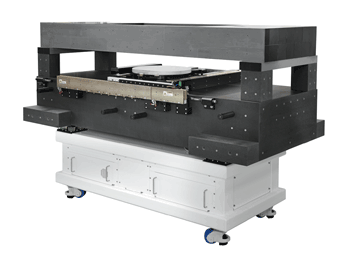
DynamYX Datum is an air-bearing stage designed for the upcoming larger 450-mm wafer sizes. Photo courtesy of Newport Corp.
“Control of precision is important in cases where features are quite small – in the order of microns and sometimes even down to the nanometer,” said Beda Espinoza, senior marketing manager of motion products at Newport Corp. in Irvine, Calif. “There is a need to manufacture these features and even to measure them. Other aspects of this trend [are] automation in hard-to-reach places, or in vacuum or cleanroom environments.”
It seems that more and more industries, including construction and the health care sector, are moving into higher-precision positioning capabilities as they seek to generate higher productivity and more differentiated products.
“In today’s modern technologies, you can find position applications involving lasers and detectors in almost any high-tech application ranging from buildings to tunnels, printing technology, machine testing, laser testing, shipyards, satellite positioning and even earth shifting,” said Ophir Mottes, marketing and application manager at beam analysis and alignment specialist Duma Optronics Ltd. in Nesher, Israel.
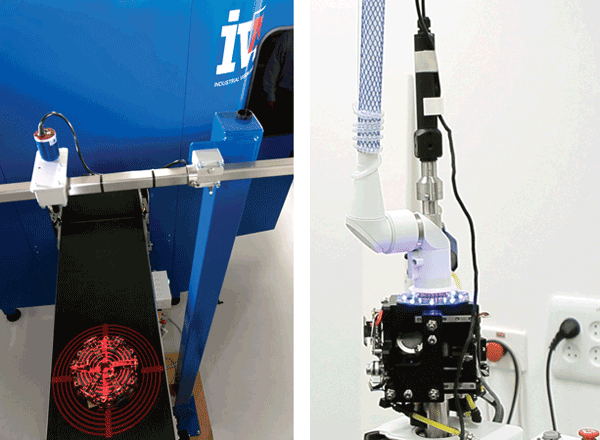
Projectors are used by Industrial Vision Systems for precision position detection.
“In mechanical and metal machining, field lasers are frequently used to measure [the] straightness of [a] long beam, such as [those] used for large-format printing, testing mechanical axes such as those used in ship propellers, and examining errors of many mechanical slideways which are mounted on a larger mechanical unit.”
At machine vision supplier Industrial Vision Systems Ltd. of Oxfordshire, England, Director Earl Yardley has noticed that the industrial automation market in general drives the technology – and this can be applied to virtually any modern factory automation process, he said.
“Our systems are generally utilized in the automotive, electronics, medical devices, pharmaceutical and food industries,” he said. “The market is continuing to grow: As more companies adopt automation technology, [there is more of] a requirement to use positioning systems in the context of machine vision and industrial automation. In addition, the newly emerging Far East markets continue to push the technology.”
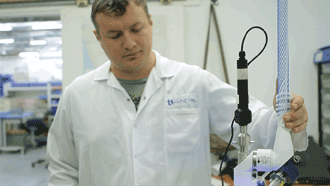
Alignment of an articulated arm delivering a CO2 laser of a medical instrument to the surgical target area.
Advances in optical detection
Several components make up a positioning system, including an imaging element, an intelligence system that works out position and movement based on feedback, and the mechanical stages that physically adjust or correct the position as necessary.
Primarily, optical linear encoders can be used to determine the position directly – for example, the PIOne sensor manufactured by precision positioning systems provider PI (Physik Instrumente) GmbH & Co. KG of Karlsruhe, Germany. The PIOne sensor incorporates a Mach-Zehnder interferometer and a high grid resolution with optimized signal processing, and provides an optical incremental encoder with a resolution down to 20 pm.

The Alignmeter from Duma Optronics is based on two sensors. It simultaneously measures the position and angle of the incoming laser beam. Here, the straightness of a printer head carriage moving along a beam is being measured. Photo courtesy of Duma Optronics Ltd.
“This is possible with a very small signal period of 0.5 µm, which allows for a high interpolation with low noise,” said Mr. Steffen Arnold, head of marketing and products at PI. “The used laser diode operates at comparably low performance to minimize the heat generated in the sensor head. To avoid the heat generation in a measuring system, the light can optionally be coupled via optical fiber in the sensor head of the PIOne sensor.”
Detection is another application. The most popular beam-positioning detectors are position-sensitive ones that track the position of a beam in angle and position.
This is possible with motorized mirror mounts that also rely on optical encoders for positioning.
Typical beam-path corrections are slow, due to source drift or environmental conditions. The beam drifts can be easily corrected by motorized mirror mounts, which can be directly integrated with the signal from the position-sensitive detector. For fast beam deviations, the FSM-300 Fast Steering Mirror from Newport can handle adjustments up to 500 Hz.
“At Industrial Vision Systems, we provide camera technology for accurate positioning. This can [involve] utilizing visible-spectrum illumination, IR or UV lighting, dependent on the application and context,” Yardley said. “In addition, we use laser projection to help determine edges for positional adjustment and measurement.”
The latest advances are in 3-D technology for optical pickup. The technology is still in its infancy, however, and there are specular reflection issues with metallic products, but continual advances in camera technology in terms of resolution and speed mean position adjustments are being carried out faster and with increased accuracy.
Image processing, positioning advances
A number of industrial image processing techniques can be employed to locate and confirm the position of objects. These include contour matching (based on a pattern trained within the vision system), edge detection and traditional thresholding/segmentation.
“In addition, some preprocessing techniques need to be combined with these methods to give accurate results – for example, smoothing filters,” Yardley said. “The biggest problems when positioning on an object edge are rotations of the object around its center of gravity, causing substantial pseudoshift. Therefore, any vision-based positioning system must include rotation and edge detection as part of the process.”
When it comes to positioning devices, advances in piezoelectric motors are closing the gap between nano- and micropositioning by combining the high stiffness and resolution of piezoelectric actuators with virtually unlimited travel ranges.
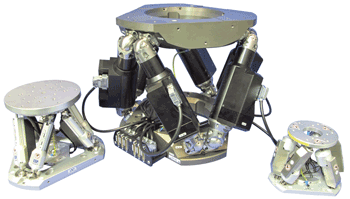
HXP is a hexapod that is appropriate for multiaxis precision positioning and higher flexibility. Photo courtesy of Newport Corp.
Today’s nanopositioners provide a positioning resolution from less than 1 nm to 100 nm and a positioning accuracy of up to 1 nm, and they require special piezoelectric drive components, too. On the other hand, micropositioners operate in the micron-accuracy range and can be operated using magnetic drives, some of which can also reach a minimum incremental motion of 1 nm.
“There are many different types of positioning systems based on the drive method. Motorized (electromagnetic) systems are generally higher precision compared to pneumatic- or hydraulic-based systems,” said Newport’s Espinoza. “Within motorized positioners, there are at least three different motor types: stepper, DC and DC brushless. These motors provide varying degrees of positioning and dynamic performance, typically used in linear or rotation stages.”
Piezoceramic-based systems, which can be grouped as piezostacks or piezo-motors, are gaining greater acceptance and can also offer high precision, Espinoza noted. “Piezostacks generally provide nanometer-level motion and higher dynamic range, but only within a few hundred microns of travel,” Espinoza said. “Piezomotors that use stick-slip, walk or ultrasonic means, on the other hand, can be faster with longer travel.”
Overcoming challenges
Commercializing miniaturization requires cost-effective systems with high throughput in industrial manufacturing. This could possibly be achieved with fast, flexible drives that can be connected to existing interfaces. But PI’s Arnold believes that the (opto)mechanical portion
of a positioning system has reached certain physical limits.
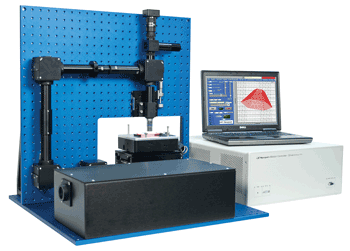
uFAB is a turnkey solution for laser machining nanometer-level structures, integrated with a vision system to operate in real time.
“The performance of the system is increasingly determined by the control electronics. Adaptive control algorithms, for instance, can easily be programmed with powerful processors and programmable components, which are available for small money,” he said. “This, however, requires knowledge and deep understanding of servo control technologies, and of the behavior of the drive and sensor components.”
The miniaturization trend is expected to continue, and nanometer positioning will become more common through advances in control design and the adoption of more stable materials. But materials with the ideal characteristics of stiffness, weight, stability and so on are still difficult to manufacture.
But the biggest challenge is the complexity in setting up such systems, according to Industrial Vision Systems’ Yardley. “It requires engineers who understand vision system technology and automation. That is why we offer the complete service to our customers. We will specify, manufacture and commission the vision system,” he said. “We find increasingly that customers neither have the time or manpower to complete this themselves.”
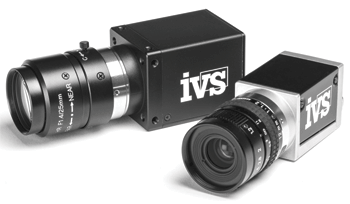
Smart vision cameras from Industrial Vision Systems provide optical positioning feedback. Photo courtesy of Industrial Vision Systems.
The fourth industrial revolution
Some industry leaders believe that we are on the verge of a sea change in manufacturing, in which intelligent factories and computerized automation will spell the beginning of the next industrial revolution. And optical position systems will play a key role in these future factories.
“Optical position systems will have increased importance in the factory of the future. With the advent of Industry 4.0 and the SMLC who are looking to promote more intelligent and ‘smart’ factories which offer lean, adaptable manufacturing, we will see optical positioning at the forefront of helping factory processes adapt to different products and batches,” Yardley said.
Industry 4.0 is a German government initiative that aims to build autonomous decision making capability into factories of the future. Meanwhile, in the U.S., a coalition of manufacturers, technology companies, universities, government agencies and laboratories are also working on the future of manufacturing. The Smart Manufacturing Leadership Coalition (SMLC) was launched in July 2012 to broaden the adoption of manufacturing intelligence.